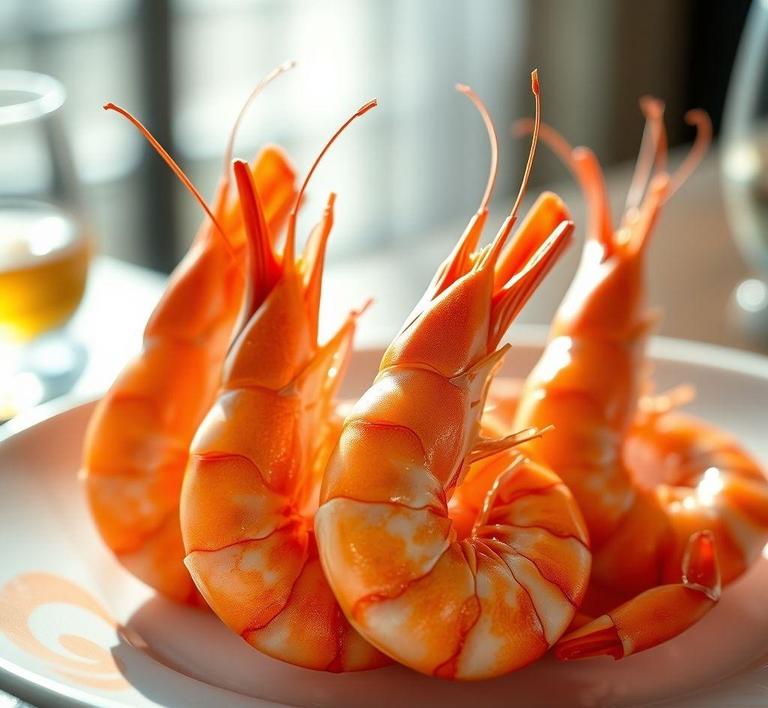So, you’ve bought a big bag of prawns, and now you’re wondering if you can refreeze them after they’ve been thawed? It’s a common question, especially when you’re not sure if you’ll use them all at once. The good news is, yes, you can refreeze prawns, but there are a few things you’ll need to keep in mind to make sure they stay safe and delicious. Refreezing prawns properly means knowing how to handle them from the moment they thaw, and making sure you do it in a way that doesn’t affect their taste or texture. In this guide, we’ll walk you through the dos and don’ts, as well as some tips to help you make the most of your seafood without any waste!
Can You Refreeze Prawns?

The short answer is: yes, you can refreeze prawns, but it’s not always ideal. Refreezing prawns (or any seafood, for that matter) is a bit of a culinary gray area. There are a few factors to consider, such as the condition of the prawns before freezing, how they were thawed, and the potential risks involved.
When prawns are first frozen, they’re preserved at their peak freshness, locking in their texture and flavor. However, when you thaw them, particularly if they’re left out for too long or at an improper temperature, bacteria can begin to grow. This makes refreezing a bit of a risky venture if not handled properly. The USDA recommends not refreezing seafood unless it has been cooked, as raw prawns that are thawed and then refrozen may not maintain their safety or quality.
It’s also important to note that the longer prawns are stored in the freezer, the more they’ll lose their original flavor and texture, even if they are refrozen right away. The delicate nature of prawns makes them more prone to freezer burn when exposed to air for extended periods. So while technically possible, you should be cautious.
How To Refreeze Prawns?
If you’ve decided to proceed with refreezing prawns, it’s crucial to follow a few key steps to minimize quality loss and reduce safety risks:
-
Ensure Freshness Before Freezing:
If prawns are still in good condition when initially frozen, they will fare better when refrozen. Make sure they have not been sitting out at room temperature for too long (never more than two hours) before freezing or thawing.
-
Thawing Process:
The way you thaw your prawns is crucial. Ideally, you should defrost them slowly in the refrigerator overnight to prevent any bacteria growth. Avoid leaving prawns on the counter to thaw, as this increases the chance of bacterial contamination. If you need them thawed quickly, submerge them in a sealed bag in cold water, changing the water every 30 minutes until thawed.
-
Cooking Before Refreezing (Optional but Recommended):
Cooking prawns before refreezing is an excellent way to preserve their safety and quality. When prawns are cooked, the risk of bacterial growth decreases significantly. Cooking also locks in moisture, so when they’re refrozen, they maintain better flavor and texture. You can sauté, boil, or grill them, but avoid overcooking, as that can lead to a rubbery texture upon refreezing.
-
Proper Packaging:
When it’s time to refreeze, the packaging method plays a significant role in preventing freezer burn and retaining quality. Use airtight containers or vacuum-seal bags to minimize air exposure. If you’re using plastic wrap or freezer bags, try to remove as much air as possible before sealing. For best results, wrap individual portions to avoid having to thaw everything at once.
-
Label and Date:
Always label and date your refrozen prawns so you can keep track of how long they’ve been stored. As a general rule, prawns should not be kept in the freezer for longer than 3-6 months, whether they’re fresh or previously frozen.
Quality Impact
Refreezing prawns can have several negative impacts on their quality, both in terms of texture and flavor.
-
Texture Degradation:
One of the most significant consequences of refreezing prawns is the texture. Prawns are naturally quite delicate, and the freezing/thawing cycle causes ice crystals to form within their muscle fibers. Each time this process occurs, it ruptures the cell walls, leading to a mushier texture when the prawns are finally cooked. This is especially true if they were thawed using high heat or in the microwave.
-
Loss of Moisture:
Every time prawns go through the freezing process, they lose some of their moisture. When frozen prawns thaw, they release water, and while some of it may be reabsorbed during refreezing, a portion of it is lost entirely. This results in prawns that may seem drier and less succulent when cooked again, diminishing their overall appeal.
-
Flavor Deterioration:
Prawns have a very subtle, sweet, and briny flavor that can diminish with every freeze-thaw cycle. Each time prawns are thawed and refrozen, they’re exposed to more air and potentially the onset of oxidation, which leads to a loss of that fresh seafood flavor. Additionally, any changes in the freezing temperature or a longer storage time can intensify this flavor deterioration.
-
Freezer Burn:
Prawns are particularly vulnerable to freezer burn, which happens when food is exposed to air in the freezer. This causes dehydration and the formation of ice crystals on the surface of the prawns, which affects both their texture and taste. To avoid this, proper packaging is essential.
While it is technically possible to refreeze prawns, it comes with trade-offs in terms of quality and safety. The key considerations are the method of thawing, the timing, and how you store them. If you’re concerned about quality, cooking the prawns before refreezing is the safest option. If you’re set on refreezing raw prawns, make sure they were initially frozen while still fresh, thawed properly, and sealed with care.
Ultimately, for the best taste and texture, it’s recommended to avoid refreezing seafood unless absolutely necessary. If you know you won’t use them within a few days after thawing, it’s better to cook the prawns and freeze them as a prepared dish, preserving both the safety and flavor.
In the world of seafood, it’s always better to err on the side of caution, as prawns are delicate creatures that demand careful handling. So, next time you’re unsure, it’s often best to either cook them up or plan to consume them soon after thawing-enjoying them at their freshest and most flavorful.
Is It Safe To Refreeze Prawns?
Refreezing prawns is a topic that often raises questions in the kitchen, particularly when dealing with leftovers or seafood that has been thawed but not used. While refreezing prawns isn’t always dangerous, it comes with certain risks that must be carefully managed to ensure the prawns remain safe to eat and maintain their quality. The key factors that influence the safety of refreezing prawns are how they were initially frozen, how they were thawed, and the conditions under which they were stored.
Prawns are highly perishable, and if they’ve been thawed improperly or kept at unsafe temperatures, bacteria can grow quickly. Refreezing prawns that have been thawed in the fridge or on a clean, controlled surface is usually safe as long as the prawns haven’t been left out at room temperature for an extended period. However, if they were thawed at room temperature or in warm conditions, refreezing them can significantly increase the risk of foodborne illness.
The quality of prawns can also degrade each time they are frozen and thawed. When prawns freeze, the water in their cells expands and forms ice crystals, which can damage the cell walls. Thawing and refreezing this product can cause further degradation, leading to a mushier texture and loss of flavor. If you do decide to refreeze prawns, it is advisable to cook them first to prevent further spoilage and texture loss.
Signs That Prawns Should Not Be Refrozen
Recognizing when prawns should not be refrozen is essential to avoid health risks and poor-quality meals. There are several clear signs that indicate prawns should not be refrozen, including:
- Odor: Prawns should have a fresh, briny smell when raw or cooked. If they emit a sour, ammonia-like, or “off” odor, this is a strong indication that they’ve begun to spoil and should not be refrozen. A pungent or unpleasant odor suggests the presence of bacteria, which can be harmful if consumed.
- Slimy Texture: Fresh prawns are firm and slightly moist. If they have developed a slimy or overly mushy texture, this is a sign of bacterial growth and degradation, making them unsuitable for refreezing.
- Discoloration: Prawns that are discolored, turning a grayish, yellow, or dull appearance, should not be refrozen. Fresh prawns are typically translucent or light pink, and any change in color may indicate that they are no longer safe to eat.
- Improper Storage: If prawns have been stored improperly (e.g., left out at room temperature for more than 2 hours or thawed in hot water), they should not be refrozen. Bacteria can multiply rapidly at unsafe temperatures, increasing the risk of foodborne illnesses.
- Visible Ice Crystals or Freezer Burn: When prawns are refrozen, ice crystals form, and sometimes this results in freezer burn-patches of discoloration that appear when food has dried out. If prawns show signs of freezer burn, it doesn’t mean they’re unsafe to eat, but their quality will suffer. Refreezing such prawns might not yield a satisfactory meal.
Common Refreezing Mistakes
Even with the best of intentions, there are several common mistakes people make when it comes to refreezing prawns. Avoiding these errors can help ensure that your prawns are both safe and delicious after they’re refrozen:
- Thawing Too Quickly: When prawns are thawed in a rush-say, in hot water or on the counter-they can reach unsafe temperatures, which allows bacteria to multiply. It’s important to thaw prawns in the fridge (ideally overnight) or under cold running water to keep them at a safe temperature.
- Refreezing Raw and Cooked Prawns Together: A mistake many home cooks make is refreezing raw prawns alongside cooked prawns. While both are susceptible to spoilage, cooked prawns often spoil more quickly than raw ones due to the changes in their structure during cooking. Mixing them together increases the risk of both types going bad.
- Refreezing Prawns Multiple Times: Every time prawns are thawed and refrozen, the quality deteriorates, and the risk of bacterial growth increases. It’s essential to only freeze prawns once if you can avoid it, or better yet, cook them before refreezing to halt bacterial growth.
- Using Improper Containers: Storing prawns in improperly sealed bags or containers can lead to freezer burn. It’s important to use airtight containers or vacuum-sealed bags when freezing prawns to protect them from air exposure, which can dry out and spoil the meat.
- Not Cooking Prawns Before Refreezing: As mentioned earlier, refreezing prawns raw can lead to textural and flavor loss. If you plan to refreeze prawns, consider cooking them first. Cooking halts bacterial growth and makes them safer to store for later.
Tips And Tricks
To help maintain the safety and quality of your prawns when freezing and refreezing them, here are some tips and tricks:
- Flash Freezing: To prevent prawns from clumping together when frozen, spread them out in a single layer on a baking sheet and freeze them for an hour or two. Once they’re frozen individually, transfer them to airtight bags or containers. This method allows you to take out just the amount you need later without defrosting the entire batch.
- Vacuum-Sealing: For long-term storage, vacuum-sealing prawns helps protect them from air exposure, reducing the risk of freezer burn and preserving their quality. It also helps to preserve the texture and flavor when refrozen.
- Labeling and Dating: Always label and date your prawn storage containers. This helps you keep track of how long they’ve been frozen and gives you a sense of how fresh they might still be. Ideally, prawns should be consumed within 3-6 months of freezing.
- Defrost Gradually: If you need to thaw prawns, do so slowly by moving them from the freezer to the fridge. This keeps them at a safe temperature and prevents the growth of harmful bacteria.
- Never Refreeze After Thawing at Room Temperature: If prawns have been left out at room temperature for an extended period, discard them. It’s simply not safe to refreeze seafood that’s been exposed to such conditions.
- Cooked Prawns Can Be Safely Refrozen: If you’ve already cooked prawns and want to save leftovers, go ahead and freeze them. Cooking eliminates most bacteria, making it safer to refreeze. However, keep in mind that the texture might suffer slightly upon reheating.
Conclusion
Refreezing prawns can be done safely, but it requires careful attention to handling, thawing, and storage practices. While it’s not inherently unsafe, improper methods such as thawing at room temperature, refreezing multiple times, or ignoring the signs of spoilage can lead to foodborne illness or compromised quality. By following the right steps-thawing prawns in the fridge, using airtight containers, cooking before refreezing, and paying attention to their smell, color, and texture-you can ensure that your prawns remain delicious and safe to eat even after refreezing. Remember that while prawns are at their best when freshly prepared, knowing how to handle leftovers properly will minimize waste and extend the enjoyment of your seafood dishes.


